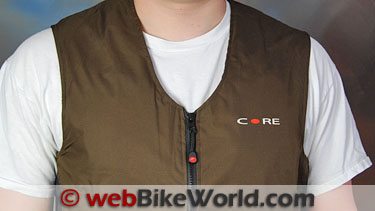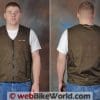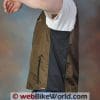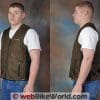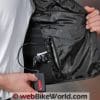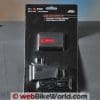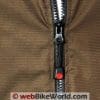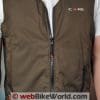The Gerbing Battery Powered Core Heat Vest Liner takes the chill off, whether you’re on or off the bike.
It is very lightweight and thin, allowing it to be used under any motorcycle jacket, despite Gerbing’s claims to the contrary.
Gerbing is well known in the motorcycling community for its wired heated clothing.
But other than the Gerbing Hybrid heated gloves we reviewed in 2009, Gerbing seems to be a bit behind the times when it comes to wireless heated garments for motorcycle use.
The Gerbing Hybrid heated gloves (review) are an exception. They can be connected directly to the motorcycle or to another Gerbing heated garment, like the Gerbing Heated Jacket Liner (review).
The “Hybrid” label means that Gerbing battery packs can also be used to power the gloves and they work very nicely to provide a strong heating output without wires.
So overall, the Hybrid gloves are excellent and are among the warmest we have tried, even though they are a bit bulky and the location of the battery makes the gauntlet a tight fit over a winter jacket.
Other than the Hybrid gloves, there are no other “Hybrid” or “wireless” heated vests or jackets in the Gerbing “Powersports Gear” product line as far as I can tell.
Click on the “Battery Power” link and you’re directed to a sub-site, devoted to the Gerbing wireless heated clothing line, called “Core Heat”.
The Core Heat product line is designed for the outdoor sports, hunting and fishing and casual user market.
The battery heated clothing in this lineup includes gloves, socks, hand warmers, jackets and even heated seats.
The Core Heat product line also includes three types of battery heated vests: the Core Heat Soft Shell Vest, Fleece Vest and the Core Heat Vest Liner I am describing in this review.
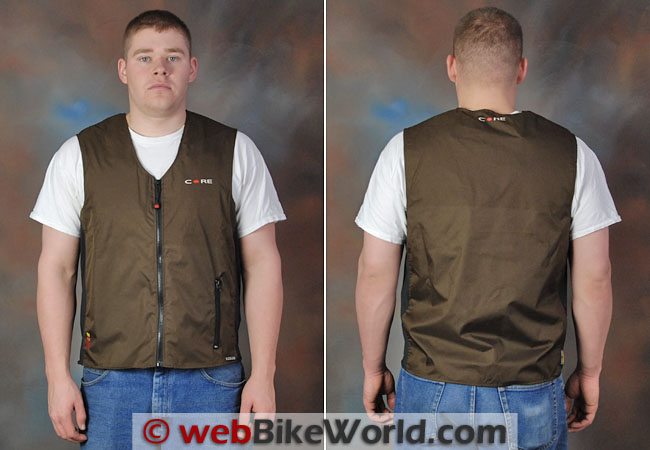


Thin, Lightweight Wireless Warmth
Gerbing specifically states that the Core Heat Vest Liner is “not designed to be used on motorcycles”.
That statement immediately piqued my interest and, ever the contrarian, I took it as a challenge. What could possibly be so different about this heated vest that would make it unsuitable for use on a motorcycle?
I don’t know the answer to that question. My only guess is that Gerbing figured that accessing the battery, which also contains the heat setting controls, is slightly inconvenient when the vest is worn under a motorcycle jacket.
Otherwise, it seems like a good solution for motorcycle use.
In fact, the Core Heat Vest Liner has a few real advantages — besides the wireless heat, of course, which is a huge advantage in and of itself.
Now that I think about it, the word “Liner” in the name of Core Heat Vest may be apt, because this vest is designed to be thin and it feels almost weightless at 275 grams (9.7 oz.) plus 107 grams (3.7 oz.) for the battery.
The light weight and thin construction allows the vest to be worn under any motorcycle jacket while adding only the bare minimum amount of bulk.
This is an important feature, because even a heated jacket liner can add too much thickness under a properly-fitted motorcycle jacket.
How thin is it? Just to give you an idea, I used a micrometer to measure the material that makes up the body of the vest.
The vest has a brown ripstop external shell and a black taffeta lining and the combined thickness is only 1 mm, and that was measured over a seam, which is the thickest part.
This is a real advantage for wearing the vest under a motorcycle jacket. Just to give you an idea of how thin the vest is, the zipper pull, including the runner is 10 mm thick, 10 times as thick as the body of the vest.
I also measured over the wires that run through the vest that provide the heat, and including the vest material on either side, they measured only 5 mm thick.
The thin construction doesn’t mean the vest is fragile. While I can’t say it’s as ruggedly made as, for example, the EXO 2 StormRider (review), with proper care the Gerbing Core Heat Vest Liner seems perfectly adequate and so far has provided good service.
The main point is that the design of this vest is a real advantage for motorcycle use because, for all practical purposes, it has zero bulk and zero weight, yet it provides wireless warmth.
I would think Gerbing would be shouting from the rooftops about this!
Construction Notes
The Gerbing Core Heat Vest Liner has an unbranded nylon-tooth zipper in the front with the runner located on the left side. The zipper and the other seams use single- and double-row stitching.
The stitching is straight and even, with a few loose threads that slightly marred the overall impression of quality.
The battery is stored in a zippered pocket on the inside of the left half of the jacket, located at the side just in front of the elastic material that forms the sides of the vest.
Another storage pocket is located on the outside of the vest on the left-hand side.
The inside pocket isn’t the handiest location for a battery, and only after wearing the vest a few times did I notice that the outside pocket has a small push-through rubber grommet that allows the wire for the battery to be pushed through.
This is a much better location for the battery, which also contains the buttons to control the vest.
The wire that connects to the battery is continuous, running from the battery up the front left side of the vest, around the neck, down the back in a zig-zag pattern, and it ends on the other side of the neck a about 150 mm down the front.
Battery Power
The battery that powers the Core Heat Vest Liner heated vest is a 7 Volt, 2200 mA rechargeable lithium-ion unit. It measures 69 mm long by 20 mm thick and 42 mm wide and it weighs 107 grams (3.7 oz.).
It has a small female RCA-type plug in the top and the vest has a built-in male 3.5 mm jack connector on a wire with plenty of length to attach to the battery and store it either on the inside or outside pocket.
The controller for the heated vest is built into the battery case.
The battery has a built-in display panel with LED lights. Press the membrane switch once to turn on the vest at its highest (labeled 100%) setting, and then press again for 75%, 50%, 25% and off.
A small green LED will light next to each numbered stage.
The vest comes with the battery and a small charger. Simply plug the charger into a wall outlet and plug the male connector from the charger into the battery and the automatic charging program takes over.
I didn’t measure the amount of wire on the charger because I don’t want to undo the nicely bundled wire, but I’d guess there’s 50 cm or so.
The battery even has a little “beep” sound every time the button is pressed, and the charger has a tone sound also that goes off briefly when it’s plugged in.
The charger also has a light that turns red when it’s charging and green when it’s done and the battery does the same.
So this is a lot of information actually, out of a tiny unit.
Gerbing says the 7.7 Watt battery draws 1.1 Amps and provides a surface temperature of 135 degrees F. I measured the heat over the wires on the inside of the vest (over the lining) at a maximum of 88 degrees F with the very handy Temp Gun infrared thermometer (review).
The battery lasts about as long as claimed: 2 hours at 100% (the highest setting) to 10 hours at 25% (the lowest setting and doesn’t really provide enough heat to notice).
I get about 2 hours at 100% and up to 4-5 hours when I’m throttling it back and forth among lower settings, never using anything less than 50%. I haven’t exactly timed the charging but it takes about 2-4 hours to charge the 2.2 Ah battery from empty.
The li-ion battery pack is standard across the Core Heat product line, and extra batteries can be purchased for a reasonable $39.95.
Gerbing also offers a 4 Ah battery for $69.95 and an 8 Ah battery kit for $189.95, which should power the vest for as long as you dare to wear it.
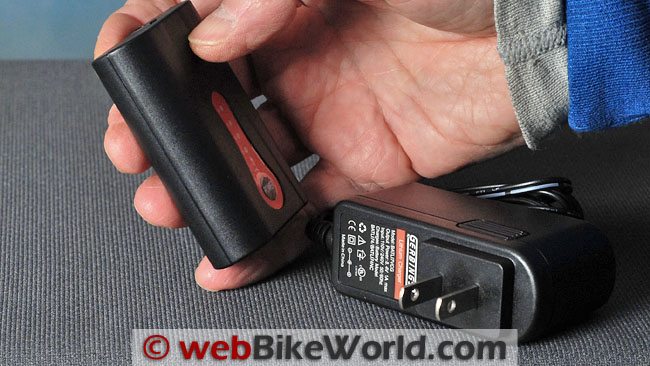


Using the Gerbing Core Heat Battery Heated Vest
Let’s face it, with only around 8 Watts, you won’t be hard-boiling any eggs inside this vest.
Turn it up to the 100% setting and it takes about 3-4 minutes to feel the warmth, which comes in with a just-noticeable feel.
The “Core Heat” wires start about mid-chest on the left-hand side and the warmth spreads gently around the neck, along the upper back and around the right-hand side of the neck.
It isn’t an overwhelming amount of heat by any means, but it is a nice, even warmth. The 100% setting can actually feel too warm in some circumstances; for example, if I’m wearing a tight-fitting jacket over the top.
But if I wear the vest with nothing over it, like I do around the house, the 100% setting works best.
The vest doesn’t put out as much heat as any of the wired heated vests I’ve tried and it’s probably about 75% of the heat produced by the Jett battery heated vest (review).
But the overall construction and the light weight of the Gerbing heated vest, combined with the convenience of the battery and the charger, and the relatively low price make this an excellent solution and I have been using it on winter rides and very much enjoying it.
Sizing Issues
It’s very important to make sure a heated garment fits tightly against the body so the heating elements can work at maximum efficiency.
I normally take a men’s size large and I bought the Gerbing’s heated vest in the size L/XL after referencing the size chart on the Gerbing website. As it so happens, I think the Gerbing sizing is incorrect.
The vest has a large section of thin elastic on either side that is supposed to keep the vest tight to the body, but this size L/XL definitely feels more like an XL.
Gerbing says the size large will fit a 39 to 44 U.S. men’s chest, but there’s absolutely no way that this size is correct for a 39, 40 or even a 42, in my opinion.
In fact, I’m a 44 and it’s too big for me, even when wearing it over a T-shirt, thermal undershirt and sweatshirt, so I should have returned it for a medium.
The elastic on the sides doesn’t even start to stretch, and you can see from the side view of the photos of the model, who is larger than me and normally takes an XL, that the vest isn’t snug enough.
I may actually take in a few stitches on either side in the elastic to get the body of the vest to fit more tightly. It’s better when I wear a snug-fitting motorcycle or other jacket on top, or when I wear the vest under a sweatshirt.
So if this example is indicative of the sizing, I think the L/XL should fit a 43 a the minimum and probably a 45 or even a 46 at the maximum.
Again, I think the L/XL is simply too big for anything smaller than a 43 or 44 and remember that the vest needs to fit tight to the body for maximum effectiveness.
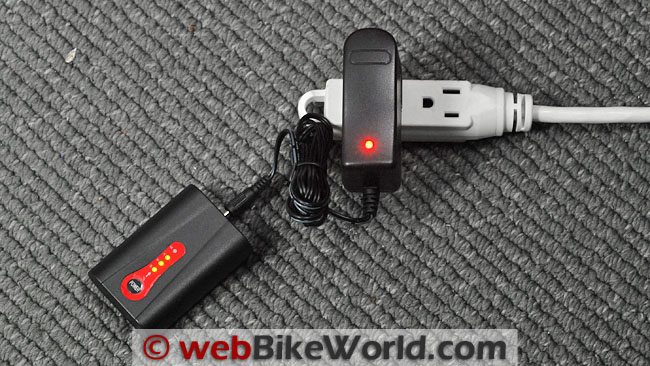


Conclusion
While the Gerbing Core Heat Vest Liner may not provide scalding heat for winter motorcycle rides, it has many advantages that are hard to ignore.
It fits under any motorcycle jacket due to its thin construction and very light weight.
The battery is compact and convenient and clearly indicates each of the four heat levels.
While the heat isn’t overwhelming, it is there and it’s just enough to take the chill off. And the vest is just as useful off the bike, around the house or for general use.
Make sure you buy the correct size to ensure that the vest fits snugly against your body and I think you’ll find that this is one heated vest that is a good solution for all-around wireless warmth.
More wBW Heated Clothing Reviews | Motorcycle Glove Reviews
|
wBW Product Review: Gerbing Core Heat Battery Heated Vest
|
|
|---|---|
| Manufacturer: Gerbing’s Heated Clothing | List Price (2011): $99.00 |
| Colors: Black. | Made In: China. |
| Sizes: XS to XXL | Review Date: January 2011 |
Owner Comments and Feedback
See details on submitting comments.
Other WebBikeWorld Cooling Vest Posts


